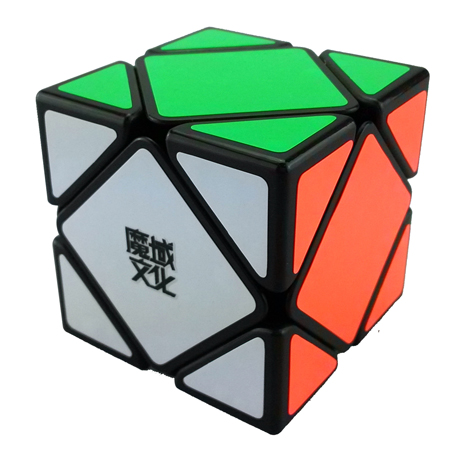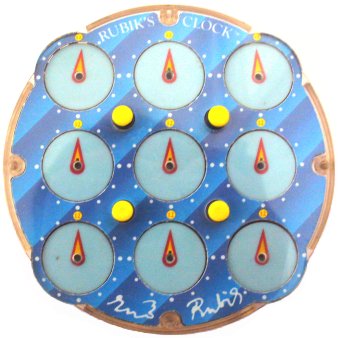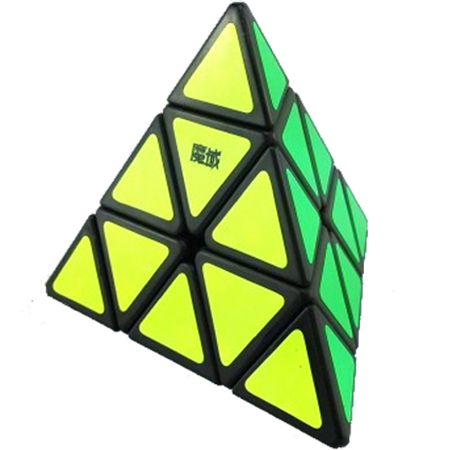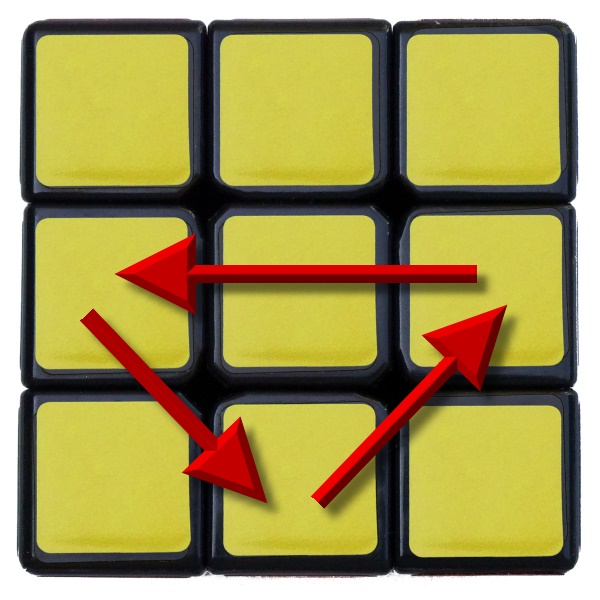How to solve the
Rubik's Cube

Content
- History
- 5 Facts
- Basic Knowledge
- Cross
- First Layer
- Second Layer
- Last Layer Cross
- Last Layer Edges
- Last Layer Corners
History

1976 - Invention by
Erno Rubik

1980 - Great Popularity

Revival through the internet

5 facts
1. Possible Positions
43'252'003'274'489'856'000
( ≈43 Quintillion)
2. Optimal Solution
20 Moves
( 35 years of calculation for one processor)
3. World Record
5.25s - Collin Burns '15
What is the world record for the fastest solve?
4. Different Puzzles









Pyraminx
2x2
4x4
5x5
6x6
7x7
Megaminx
Skewb
Square-1
Rubiks Clock

5. Different Categories




One-Handed
With Feet
Blindfolded
Multi-Blindfolded
Basic knowledge

Components
- Centers
- Edges
- Corners
Methods
- We learn the Beginner Method
- An advancement of the Beginner Method is the Fridrich-Method
- We learn 6 Algorithms in the Beginner Method
- In the Fridrich-Method you learn up to 100 Algorithms
Notation

What is the notation?
- Description of a rotation of one side
- Is required to perform algorithms
- Also required to scramble the cube
- The whole solution is based on the notation
basic rules of the Notation
Normal Move


' Suffix
2 Suffix


Standard-Notation
R
L
U
D
F
B
Standard-Notation
R'
L'
U'
D'
F'
B'
Standard-Notation
x
x'
y
y'
z
z'
Exercises
- R U R' U'
- D L' U F2 B2
- B2 F2 U' L D'
- L2 F2 U' F2 D B2 F2 D2 L
Cross
What is the Cross?
- First step
- The first time, we make it on white
- The Cross-Edges need to be correct on both sides
Procedure
- Search the matching edge
- Turn the edge below the target
- Turn up the Edge
-
If the Edge is twisted incorrectly-> F U' R U'
Example
Scramble: L2 F2 U' F2 D B2 F2 D2 L
The white-orange Edge is already in the top layer -> U
In the bottom layer, there is the White-Green Edge.
This Edge must go below the Green Center -> D2
And has to be turned to the top layer-> F2
In the bottom layer there is the White-Red Edge.
This Edge must go below the Red Center -> D'
And has to be turned to the top layer -> F2
The last Edge (White-Blue) is placed on the red side
This Edge must turned down to the bottom layer -> F
Afterwards the Edge has to go below the blue center-> D
Because we moved the White-Red Edge, it has to go back up again -> F'
And now, the White-Blue Edge can be turned up -> F2
Exercises
- Cross on the Yellow-Side
- Cross on the Red-Side
- etc.
First Layer
What is the First LayeR?
- Whole site correct
- For this step, the Corners need to be inserted
Procedure
- Search the correct Corner
- Turn Edge below its target
- Perform Algorithm -> R' D' R D
-
As long as the Corner is correctly inserted
Exception
Is a corner already in the top layer, you have to perform the Algorithm ( R' D' R D ) once.
Exercises
- Solve five times one side
- The colour is arbitrary
Second Layer
What is the Second Layer?
- Two Layers need to be arranged correctly
- For this step, we need to insert 4 Edges
- Two algorithms are required
- The Cube has to be turned upside-down
Procedure
- Search an edge in the Top Layer
- Turn the Edge to the correct position
- Determine Case
- Perform the according algorithm
Search an edge in the top-layer
We search a non-yellow side in the top-layer
Turn the Edge to the correct Position
- The bottom side of the edges has to match the colour of a center
- Only U-Moves are required
U'
Determine Case and perform algorithm
To the Left
To the Right
U R U' R' U' F' U F
U' L' U L U F U' F'
Learn Algorithms
- Search patterns
- Repeat
(U' L' U L) (U F U' F')
(U R U' R') (U' F' U F)
Exercises
- Memorize the algorithms
- Solve the Second Layer till you feel safe about it
Last Layer Cross
Overview
Only Algorithm for this step
(F R U) (R' U' F')
- Cross on the last layer
- We have to regard the edges only
- There is just one algorithm for this step
Determine Case and perform algorithm
Dot
L-Shape
Line
Alg -> L-Shape
2 times Alg
Alg
(F R U) (R' U' F')
Last Layer edges
Overview
- Orienting the Edges
- We have to regard the edges only
- There is just one algorithm for this step
Only Algorithm for this step
(R U R') U (R U2 R') U
Determine Case and perform algorithm
2 adjacent correct pieces
No adjacent correct pieces
Alg -> 2 adjacent correct pieces
Place the two correct pieces at the back left + Alg
Hint: Sometimes you have to turn the U-Layer a couple of times (maximum 3 times) to see if there are 2 adjacent correct pieces.
lAST LAYER CORNERs
Overview
- After this last step, ther corners will be permutet and orientet correctly.
- We have to regard the cornes only
- 2 Algs are required to perform this step
Required Algorithms
(U R U' L') (U R' U' L)
Corner Permutation Algorithm
Corner Orientation Algorithm
R' D' R D
Corner-Permutation
One correct corner
No correct corner
You have to look around the whole cube to see if there is a correctly placed corner.
Correct corner on the front-right
U R U' L' U R' U' L
U R U' L' U R' U' L
<-- One correct corner
Corner-Orientation
- Get an incorrectly twisted corner to the front-right
- R' D' R D till the corner is twisted correctly
- Repeat till the cube is solved
You Solved the Cube!
Congratulations!
Impressum

Author: Tobias D. Peter
Licence: CC BY SA -
How to solve the Rubiks Cube
By Tobias Peter
How to solve the Rubiks Cube
This Presentation is an alternative to the video-only or text-only Rubiks Cube tutorials. It may be used as an assistance for a course or for self-study.
- 50,399




